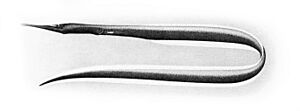Stemonidium facts for kids
Quick facts for kids Stemonidium |
|
|---|---|
 |
|
| Conservation status | |
| Scientific classification |
The Stemonidium hypomelas is a type of deep-sea eel. It belongs to the Serrivomeridae family, which are often called "sawtooth eels." This eel was first found near Niihau Island, Hawaii, in 1902. The first specimen studied was about 171 mm (6.7 in) long and was found about 1,000 m (3,280 ft) deep in the ocean.
This eel looks a bit like other sawtooth eels, but it has smaller teeth. Its teeth are more like those of a snipe eel. The Stemonidium hypomelas is not important for fishing.
Contents
Where Does This Eel Live?
The Stemonidium hypomelas lives in many parts of the Pacific Ocean and the southern Atlantic Ocean. It prefers deep waters, usually found between 500 m (1,600 ft) and 1,229 m (4,030 ft) below the surface.
Scientists have used special fishing nets called trawls to study these eels off Hawaii. During the day, most of these eels stay very deep, below 550 m (1,800 ft). Many are found between 700 m (2,300 ft) and 800 m (2,600 ft) deep. At night, some of these eels swim up closer to the surface, reaching a minimum depth of 175 m (574 ft). This movement is a type of fish migration.
What Does the Stemonidium hypomelas Look Like?
The Stemonidium hypomelas has a long, flat body that looks like a ribbon. Its body is mostly the same depth in the middle, but it gets thinner towards its head and tail.
Head and Mouth Features
The top of its head, from the back to the tip of its snout (called the rostrum), is quite straight. Its jaws are long and thin, ending in a very delicate point. The bottom jaw is a little longer than the top jaw.
Instead of sharp teeth, this eel has small, grainy plates arranged in a pattern like dots on a dice (called a quincunx). These tiny teeth point backward. Its eyes are very small and are located in the middle of its head. It has two pairs of slit-shaped nostrils in front of its eyes. The front nostrils are shorter than the back ones. The openings for its gills are long and slanted.
Fins and Body Color
Both the long dorsal fin (on its back) and the anal fin (on its belly) start about half a head length behind the gill opening. The first rays of the dorsal fin are very thin and hard to see. The anal fin is a bit taller than the dorsal fin. The fin rays on both fins get longer and closer together towards the tail.
The eel's tail is short and pointed, but it doesn't have a long, thin filament like some other eels. This eel does not have a lateral line, which is a sensory organ many fish use to detect movement and pressure changes in the water.
The top half of the Stemonidium hypomelas' body is light gray with tiny black spots. The bottom half is suddenly jet black. Its head is completely black, but it gets lighter at the tips of its jaws and the back of its head. The last part of its tail (about one-sixth) is also black. All of its fins are lighter in color than its body.
Size Differences
Male eels are smaller than female eels. Males have larger nasal rosettes (parts of their nose) and bigger eyes. Sometimes, their tails are flatter too. The longest male found was about 22 cm (8.7 in) long, while the longest female was about 37.5 cm (14.8 in) long.
Life Cycle and What It Eats
Scientists have studied the stomach contents of Stemonidium hypomelas to learn what they eat. These eels mostly feed on small crustaceans, especially euphausiids (which are tiny shrimp-like creatures). Sometimes, they also eat shrimps and amphipods.
Reproduction
The Stemonidium hypomelas reproduces by laying eggs, which is called being oviparous. Females can lay a lot of eggs, from 7,000 to almost 14,000 eggs at a time! Female eels are ready to reproduce when they are between 22 cm (8.7 in) and 30 cm (12 in) long.
Male eels mature when they are about 17.5 cm (6.9 in) to 20 cm (7.9 in) long. Their larger noses and eyes might help them find mates in the huge, open ocean where other eels are spread out.


